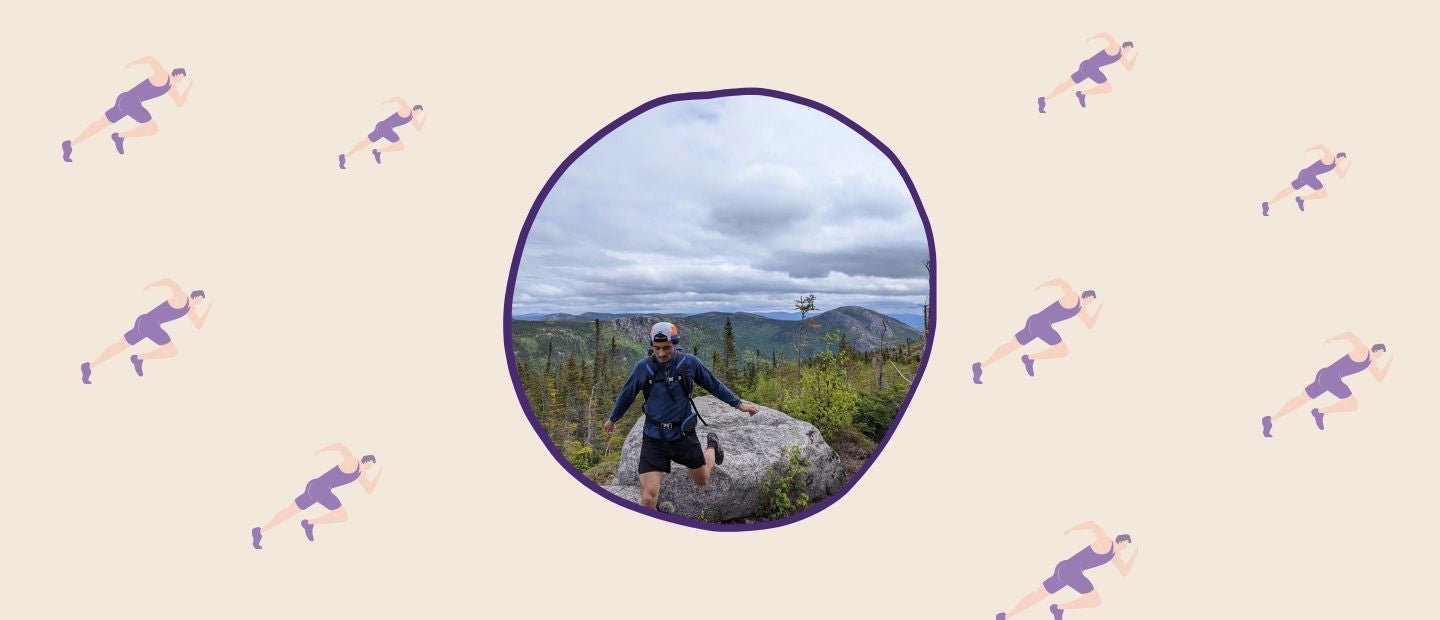This fall, I discovered a challenge called Everesting (a.k.a. “Everest challenge”). While it seems to be already quite popular with the cycling community, it’s becoming more and more popular amongst the running community as well.
What Is Everesting?
Everesting is a hill running workout/challenge. But not a small one. The objective is to climb 8848 m of elevation in a single running effort, which is equivalent to the height of the highest mountain in the world (Mount Everest).
To achieve this, the sportsmen and women choose a very pronounced slope that is usually short in distance and perform ascents and descents of that same segment over and over again. Until the right distance has been reached.
Until recently, the world record was held by a Canadian (world obstacle course champion) who had accomplished the feat of running 67 km with a positive elevation gain of 8,848 m.
This was done in 11 hours and 17 minutes on part of Mount Sutton.
Where My Own “Mont-Blancing” Started
In October, I saw several athletes in my entourage tackling this daunting challenge and it inspired me to try an Everesting type challenge as well. Being relatively new to the ultramarathon world, I set myself a little less audacious goal, which I called “Mont-Blancing” in reference to Mont Blanc, the highest mountain in Europe, which peaks at 4,807 m.
So on November 1st, my alarm clock went off at 5:00 am and I threw myself into the sporting challenge of running uphill 4,807 m of positive elevation gain in one activity!
And now, if you are planning on doing this kind of challenge, here are some tips to help you crush your challenge:
1. Choosing Your Own Everest Challenge
First, make sure to choose a challenge that suits your experience and skills.
Overall, it must be challenging, but still achievable. As this type of challenge is basically quite difficult to do, there is no point in starting at too high a level. Don’t throw yourself into a full-scale 8,848 m Everesting, as you might not be ready for it and suffer injuries.
As always in running, the watchword is “progressive evolution”.
As for myself, I didn't start with a complete Everesting. I chose to almost cut my goal in half, and still, it seemed like a big challenge to me.
Then set an official date for the challenge and begin the serious work.
2. Physical Preparation
Before embarking on this kind of “vertical challenge”, make sure you are comfortable enough to run for a long time.
Adding positive elevation gain to a run makes it much more difficult and many of us tend to underestimate this.
Even for more experienced runners, my advice would be to incorporate some fairly long walks with positive elevation gain into your workouts. And if you can train on the slope you have chosen for your end goal, that's even better!
If you want to know more about physical preparation for a long-distance event, I recommend that you read my article on mistakes to avoid when training for an ultramarathon.
3. Choose Your Slope Carefully
As I said in the introduction, these challenges are performed on short, steep slopes and are repeated several times. By doing this, the runner is able to optimize his running distance in relation to his goal, which is to accumulate as much positive elevation gain as possible.
It is therefore important to choose a steep slope that is not too bumpy and easily accessible. For example, the slope I chose was 126 m of difference in altitude for a distance of 0.44 km.

My advice would be to highlight your running segment on an application like Strava. This will allow you to know exactly how far and how steep your segment is, and how many times you'll have to go up and down.
In my case, I had to climb and descend my mountain 38 times. With this precise information in mind, I was able to prepare myself to run about 36 km in 7 hours.
4. Equipment
If you’re motivated to go on with this challenge, know that you're going to spend quite a bit of time in motion going up and down a steep slope.
What would usually be a little uncomfortable (a fold in your sock, an awkward shoelace, being a little cold, or sweating a little too much) can become very unpleasant after 3-4 hours of effort.
So, make sure you dress appropriately. But especially: be certain that you have suitable and comfortable shoes!
And if you leave before sunrise or plan to finish after sunset, don't forget your headlamp.
Another ultra-important thing for this kind of challenge is to bring hiking poles! Normally, I never run with poles, but given the nature of this challenge, I decided to go out and buy some the day before. Despite my lack of experience, I saw a real difference. It was a bit like running with four legs instead of two.
With poles, the weight is distributed on the ground with four points of contact, which considerably reduces the stress on the legs. Also, the poles provide stability and make the exercise safer while going downhill.
5. Ready? This Won’t Be an Easy One!
Everesting Requires a Lot of Energy
As I said in point 3), for the challenge I set myself, I estimated the duration of the effort at about seven hours.
For an F1 car to run efficiently for seven hours, the driver must make sure that he can fill up the tank and change the tires easily. It's the same for the racer who takes on this Everesting (or Mont-Blancing) challenge.
A runner must consume about 150 to 200 calories per hour to conserve energy over long efforts (this is an average, each runner must get to know what kind of calorie intake is most effective for him or her).
Plan food (that you like) and drinks accordingly. Have some replacement clothes and something to cheer you up if you're feeling down. And have it all set up so that it's on your itinerary or close by...
The Mental Difficulties of Everesting
Keep in mind that, unlike a race where the landscape changes all the time, you will be going around in circles a lot in this type of challenge. Like an F1 car doing its circuit in a loop.
Mentally it is more difficult! So you can plan it and prepare music, podcasts, even ask friends to run a little bit with you or to come and cheer you on.
At my 21st climb, I started feeling bad and I thought about stopping. Exhausted, I was thinking about how ridiculous it was to go up and down like that, for no reason...
I then called my brother and spent an hour on the phone talking to him. It's amazing the difference it made! Together we made six climbs and descents. By the time I hung up, I was on the 28th climb, almost 30th, and the motivation was back!
This kind of effort can be very hard physically. Everyone knows that, but we forget that mentally, it can be even harder. You have to be prepared for it.
6. Do Not Lose Count
38 ascents and descents of the same mountain, seven hours of effort.
As you can imagine, the body goes through different emotional states. You have to stay concentrated at all times to avoid injury on the way down or to manage the effort on the way up.
I was sure that I could count the repetitions in my head, that it wouldn't be a problem. "3, 5, 10, 15, it's all good... 24, 25, 26... wait, am I at 25 or 26 now?”.
Yes, it was predictable, the more time went by, the more fatigue accumulated and the more I doubted the exact number of round trips I had done!
So much so that I finished my challenge after 6h30 of effort, and 35.5 reps instead of 38... I was sure I had done enough round trips, and even made sure to do an extra half, just to be certain that I reached my virtual peak!
Here is the link to all the details of my activity published on Strava. I climbed 4496 m and not 4,807 m... You can imagine my disappointment!
A Little Tip to Keep You on Track
To prevent the same tragedy from happening to you if you don't have the cumulative positive level indication live on your watch, I advise you to make a pile of pebbles with the number of repetitions to be done. Each time you do another round trip, you remove one pebble. This way, you can't go wrong and you'll free your mind from the random counting of repetitions!
Despite the fact that I didn’t exactly reach 38 round trips, I loved this challenge!
What an ordeal it was! I keep magnificent images of the sunrise on the mountain, deer running around me, surely wondering why I am going up and down their mountain without stopping, and especially this so pleasant feeling of breaking a mental barrier, of discovering myself capable of more!

What about yourself? When do you start?










